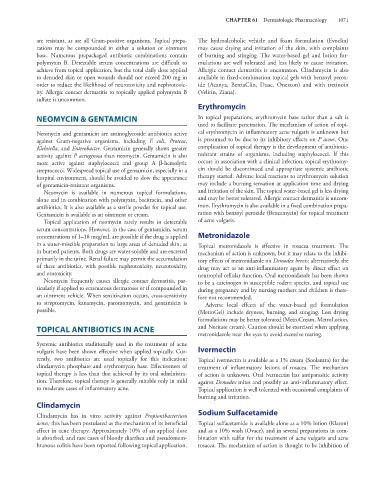Page 1085 - Basic _ Clinical Pharmacology ( PDFDrive )
P. 1085
CHAPTER 61 Dermatologic Pharmacology 1071
are resistant, as are all Gram-positive organisms. Topical prepa- The hydroalcoholic vehicle and foam formulation (Evoclin)
rations may be compounded in either a solution or ointment may cause drying and irritation of the skin, with complaints
base. Numerous prepackaged antibiotic combinations contain of burning and stinging. The water-based gel and lotion for-
polymyxin B. Detectable serum concentrations are difficult to mulations are well tolerated and less likely to cause irritation.
achieve from topical application, but the total daily dose applied Allergic contact dermatitis is uncommon. Clindamycin is also
to denuded skin or open wounds should not exceed 200 mg in available in fixed-combination topical gels with benzoyl perox-
order to reduce the likelihood of neurotoxicity and nephrotoxic- ide (Acanya, BenzaClin, Duac, Onexton) and with tretinoin
ity. Allergic contact dermatitis to topically applied polymyxin B (Velitin, Ziana).
sulfate is uncommon.
Erythromycin
NEOMYCIN & GENTAMICIN In topical preparations, erythromycin base rather than a salt is
used to facilitate penetration. The mechanism of action of topi-
Neomycin and gentamicin are aminoglycoside antibiotics active cal erythromycin in inflammatory acne vulgaris is unknown but
against Gram-negative organisms, including E coli, Proteus, is presumed to be due to its inhibitory effects on P acnes. One
Klebsiella, and Enterobacter. Gentamicin generally shows greater complication of topical therapy is the development of antibiotic-
activity against P aeruginosa than neomycin. Gentamicin is also resistant strains of organisms, including staphylococci. If this
more active against staphylococci and group A β-hemolytic occurs in association with a clinical infection, topical erythromy-
streptococci. Widespread topical use of gentamicin, especially in a cin should be discontinued and appropriate systemic antibiotic
hospital environment, should be avoided to slow the appearance therapy started. Adverse local reactions to erythromycin solution
of gentamicin-resistant organisms. may include a burning sensation at application time and drying
Neomycin is available in numerous topical formulations, and irritation of the skin. The topical water-based gel is less drying
alone and in combination with polymyxin, bacitracin, and other and may be better tolerated. Allergic contact dermatitis is uncom-
antibiotics. It is also available as a sterile powder for topical use. mon. Erythromycin is also available in a fixed combination prepa-
Gentamicin is available as an ointment or cream. ration with benzoyl peroxide (Benzamycin) for topical treatment
Topical application of neomycin rarely results in detectable of acne vulgaris.
serum concentrations. However, in the case of gentamicin, serum
concentrations of 1–18 mcg/mL are possible if the drug is applied Metronidazole
in a water-miscible preparation to large areas of denuded skin, as Topical metronidazole is effective in rosacea treatment. The
in burned patients. Both drugs are water-soluble and are excreted mechanism of action is unknown, but it may relate to the inhibi-
primarily in the urine. Renal failure may permit the accumulation tory effects of metronidazole on Demodex brevis; alternatively, the
of these antibiotics, with possible nephrotoxicity, neurotoxicity, drug may act as an anti-inflammatory agent by direct effect on
and ototoxicity. neutrophil cellular function. Oral metronidazole has been shown
Neomycin frequently causes allergic contact dermatitis, par- to be a carcinogen in susceptible rodent species, and topical use
ticularly if applied to eczematous dermatoses or if compounded in during pregnancy and by nursing mothers and children is there-
an ointment vehicle. When sensitization occurs, cross-sensitivity fore not recommended.
to streptomycin, kanamycin, paromomycin, and gentamicin is Adverse local effects of the water-based gel formulation
possible. (MetroGel) include dryness, burning, and stinging. Less drying
formulations may be better tolerated (MetroCream, MetroLotion,
TOPICAL ANTIBIOTICS IN ACNE and Noritate cream). Caution should be exercised when applying
metronidazole near the eyes to avoid excessive tearing.
Systemic antibiotics traditionally used in the treatment of acne
vulgaris have been shown effective when applied topically. Cur- Ivermectin
rently, two antibiotics are used topically for this indication: Topical ivermectin is available as a 1% cream (Soolantra) for the
clindamycin phosphate and erythromycin base. Effectiveness of treatment of inflammatory lesions of rosacea. The mechanism
topical therapy is less than that achieved by its oral administra- of action is unknown. Oral ivermectin has antiparasitic activity
tion. Therefore, topical therapy is generally suitable only in mild against Demodex mites and possibly an anti-inflammatory effect.
to moderate cases of inflammatory acne. Topical application is well tolerated with occasional complaints of
burning and irritation.
Clindamycin
Clindamycin has in vitro activity against Propionibacterium Sodium Sulfacetamide
acnes; this has been postulated as the mechanism of its beneficial Topical sulfacetamide is available alone as a 10% lotion (Klaron)
effect in acne therapy. Approximately 10% of an applied dose and as a 10% wash (Ovace), and in several preparations in com-
is absorbed, and rare cases of bloody diarrhea and pseudomem- bination with sulfur for the treatment of acne vulgaris and acne
branous colitis have been reported following topical application. rosacea. The mechanism of action is thought to be inhibition of

